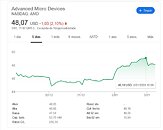Friday, January 3rd 2020

AMD Stock Broke All-Time Record for the Company, Peaked at $49.10 per Share
AMD veterans yesterday must've sneakily left their respective offices yesterday for a well-deserved rest and a glass of champagne - and if they didn't, they deserved it. The company yesterday broke their previous all-time stock pricing record achieved way back in June 2000, at $47.50 per share, when it traded at $49.10 per share yesterday.
It's been a long time coming for AMD, and irrespective of any brand loyalty, it certainly pays, as a consumer and as an enthusiast, to see a company that nearly went bankrupt in 2016 - who had to sell and then lease back their own headquarters for a quick cash infusion, spin-off its manufacturing division in a change of strategy that couldn't have been easy on morale - achieve such a colossal feat. Even more impressive this is should you even be considering the blue behemoth the company actually has to contend with - a $260.35B Intel who, by both happenstance and poor CPU execution vision, is being fired upon on all markets by comparative David AMD, today valued at $51.07B. Here's hoping all AMD employees got their well-deserved party and standing ovation from each other. None of them - not even Lisa Su - achieved this alone.
Sources:
Market Cap, via Tom's Hardware
It's been a long time coming for AMD, and irrespective of any brand loyalty, it certainly pays, as a consumer and as an enthusiast, to see a company that nearly went bankrupt in 2016 - who had to sell and then lease back their own headquarters for a quick cash infusion, spin-off its manufacturing division in a change of strategy that couldn't have been easy on morale - achieve such a colossal feat. Even more impressive this is should you even be considering the blue behemoth the company actually has to contend with - a $260.35B Intel who, by both happenstance and poor CPU execution vision, is being fired upon on all markets by comparative David AMD, today valued at $51.07B. Here's hoping all AMD employees got their well-deserved party and standing ovation from each other. None of them - not even Lisa Su - achieved this alone.

85 Comments on AMD Stock Broke All-Time Record for the Company, Peaked at $49.10 per Share
www.computerhope.com/history/processor.htm
No to fakes!
Hypocrisy. :banghead: :roll:I do remember *Anandtech reviewing the PD first, and they pointed out that Intel was first. Can't find it now tho.
Other sites show different dates, with the 25th for PD, and the 31st for X2.
X2: www.theregister.co.uk/2005/05/31/amd_athlon_64_x2/
X2: www.computerworld.com/article/2556702/amd-launches-dual-core-athlon-64-x2.html
PD: www.extremetech.com/extreme/75294-intels-pentium-d-price-half-that-of-amds-x2
The situation is pretty much the opposite now with AMD's new models.
In 2006 AMD was like Intel. It not only did its own chip design, it had its own Fabs. Even after GloFlo split off, AMD was locked into using their process nodes. A big part of the reason AMD faltered was due to falling behind in fab process technology. No more.
AMD focus' almost entirely on chip design now. TSMC, Samsung, and GloFlo have to worry about the process tech not AMD. These companies are not flyweights. Samsung overall has 3x Intel's revenue (~$210B). TSMC, more than half of Intel's revenue (> 35B). TSMC is far more focused on a particular service than Intel , Samsung much less so. Other much larger companies have vested interest in the success of partners like TSMC (see Apple).
You have mobile / ARM SoCs which continue to pour money and resources into these fabs. They are not in the slightest dependent on AMD, Nvidia, or any other single customer.
This is an entirely different landscape and Intel hasn't shown any capability for quite some time, not only failing in execution (process fab) but in strategy. Core was a derivative of the Pentium-M, which was downplayed vs NetBurst until it became obvious that NetBurst was a failure. Then they sort of dug up Pentium-M and reworked it into Core. It wasn't strategy, they just bumbled into something good that saved their tails.
Highly unlikely that'll happen again.
Glue together desktop dies, according to Intel own marketing slides should be completely useless :laugh:
What is even more ironic is the 28-core XCC dies are technically HEDT dies now,
so Intel also glued together 2 of them to make the 56-core Xeon 9200 series.
I don't really think it's as unlikely as you think it is... AMD was unlikely with Zen - that was a rabbit out of a hat; but again, the guy that did that has been at intel for the last 3 years.
Simply put don't expect miracles from the Man, while a double digit IPC is likely with one or both of the upcoming *coves but again you've also seen absolute frequency go down on 10nm & will likely go down further on 7nm. Intel & AMD will be fighting a bitter freq vs IPC battle as the nodes get smaller, so any potential rabbit out of the hats will be rarer still.
But then the epic fail of that era was probably AMD Quad Platform which didn't even have the glue
It also overclocked like a champ.
The issue with how Intel did the Pentium D and Core 2 Quads were the 2 dies were connected via the external Northbridge.
So as you expect there would be a latency hit for doing that. Ironically the Zen 2 IO die is basically an internal Northbridge.
So we went from external to on die, then to off the die but still in the CPU package. o_O
AMD will see more growth, but long term, this is a niche market and the performance gains will hit a wall eventually, it's one of the reasons Nvidia is pushing RTX so hard, because they know the wall is right around the corner and they need a new strategy to sell cards 3-4 years down the line.